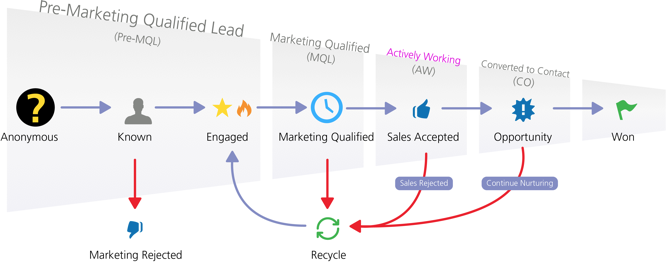Getting down to the nitty-gritty needed to properly report on lead generation and marketing revenue.

As a marketing leader, have you ever had an “oh shit” moment? It usually goes something like this - “Why are my leads down? Something must be broken somewhere...oh shit, nothing is broken! WHY ARE MY LEADS DOWN?” 😱
What if this same marketing leader knew their lead trend was going to be down ahead of time and was able to show an annual month-over-month trend to the sales leader so they could align on running a good promotion to increase growth instead?
This is the epitome of a good marketing and sales relationship, but first, every marketer needs to know how to quantify their marketing value.
Quantifying email and landing page performance into bottom-line revenue may sound frightening, but let’s discuss the foundational blocks needed to be successful at measuring and understanding your lead generation.
Regular analysis is crucial to understanding if lead generation efforts are impactful and MQLs are increasing.
We'll discuss what you need to measure your impact. Let's make some assumptions that your product or service is in demand, marketing personas are created, and all assets are top-notch with a high-performing call to actions (CTAs) and next steps.
Here’s a quick checklist before we dive deeper:
Lead Lifecycle
Attribution Method
Full-loop QA
Baseline Analysis & Reporting
Disclaimer: In a world of opinionated readers, these are basic considerations for B2B marketing that will need to be tailored to fit your current strategy and business roadmap, but it is crucial to properly measure your marketing impact no matter your business type. This blog IS a little dry compared to other blogs, but content is still good!
Marketers generate leads at any stage within the lead lifecycle, generally known as awareness, interest, consideration, and conversion. The last stage called conversions is when a lead becomes a marketing qualified lead and begins the sales process. It’s important to automate the entire lifecycle with a marketing platform that maps to your sales customer relationship management tool (CRM), and this is where we’ll focus today.
Since most of my clients use Marketo and Salesforce as their automation platform and CRM, I’ll speak using terms native to these platforms. (Please note this is not an endorsement as every business needs are different and need to be considered before choosing business tools because many tools accomplish the same goals). Marketo allows you to create a Program for each stage in the marketing lifecycle, and you'll want to customize your lead lifecycle stages so they map to your sales cycle. Your marketing campaigns at each stage in the lifecycle will vary, but quantifying lead generation starts with the pre-MQL and ends with MQL stages as shown in the Marketo diagram below. Mapping the lead through the sales cycle allows you to quantify and predict your monthly or annual revenue contributions.
Once a lead moves from anonymous to known, you can nurture these leads with your preferred content strategy applicable for their lifecycle stage and push them through to convert into an MQL or demo request. As your number of converted MQLs increase each month (or decrease), you’ll want to know how this trends with subsequent months or years.
Marketo lifecycle programs allow marketers to quickly identify how many leads are in each stage and what percentage are progressing through your lead nurture. You can also identify where leads are getting caught in your nurture, which signals the need for content or process optimization. The best part is that setting up a lead lifecycle programs allow you to easily report on conversions so you can shine bright with stakeholders.
This brings us to one of my favorite topics, attribution.
Attribution is crucial to measuring every marketing campaign or channel. It identifies every touchpoint in a lead’s journey so a marketer or business analyst can begin to identify patterns signaling a successful buyer's journey.
So, what is attribution exactly? Whether your marketing strategy includes online or offline marketing campaigns, every campaign needs to record what action or asset caused a lead to convert on the lead record. This is referred to as attribution.
I recommend collaborating with your sales leaders to standardize the different types of attribution status. Your sales team will appreciate understanding if a specific qualifying technique needs to be used.
Your attribution model is a set of rules that determines if (and how) marketing touchpoints and the conversion action will be reported. All sales, marketing and finance teams need to use the same attribution model - first touch, last touch, time decay, whatever - so reporting aligns cross-departmentally.

All of this lays the groundwork for reporting and identifying marketing revenue. Before I get ahead of myself, let’s talk about full-loop quality assurance.
By now, you have your lead lifecycle programs set up in your marketing automation tool, you have automated your attribution status, and your sales team knows how to effectively follow up with each lead based on the attribution status and the applicable sales process. Before you launch, and even intermittently throughout your fiscal year, it’s imperative to check your quality assurance (QA) to ensure your automated programs are operating as intended.
Document your lead lifecycle programs as you build them. This comes in especially handy during the QA step to understand how your programs are set up. Otherwise, things can get hairy if your marketing programs intersect each other.
For example, if two different persons become known leads by downloading an e-book and they are both pushed into an email nurture program within the interest lifecycle stage, but only Lead A clicks and interacts with the first two emails in your nurture program. Lead A should intersect and transition to the next lifecycle stage, consideration, delivering different marketing tools to convert into an MQL. If Lead B remains unresponsive, this lead would remain in the interest stage email nurture.
Each marketing program, content, workflows, nurtures, and transitions all need to be tested. Be sure to test every link and CTA. One consideration during testing is that each test may need to have a unique email address. An easy trick for this is to add a number behind your name in your email address each time you complete a form (e.g. name01@domain.com). And don’t forget to mark your lead as a test in your CRM.
Before you can understand if your marketing revenue is ahead or behind your target, you’ll need to understand your conversion baseline. The baseline data is used to measure subsequent data against it. A baseline analysis is helpful to know if marketing revenue increased each year or how a particular marketing campaign is performing.
This is a great request if you have a business analyst on the team to automate and visualize your data on a dashboard showing the baseline against current inbound leads. Even if you don’t have a business analyst, you can create a fairly raw baseline analysis as long as your reporting criteria remains constant.
The revenue analysis needs to factor how your sales team moves each lead through their sales cycle and report accordingly. Then you can create a month-over-month spreadsheet and graphs. This is helpful to see a trend, understand a seasonal view of your marketing performance, or to see how specific time periods compare.
Below is an example of a manual month-over-month report. You can see that leads increased (Row 2) between September and January. And although leads went down in February, marketing-attributed sales went up (Last Row)! Having this knowledge empowers marketing and sale leaders to make data-supported decisions, which can be drilled down to find the most profitable channels.

Each step to drive lead gen takes time and effort, but laying out these foundational steps to predict and quantify your marketing channel forecast will help understand your ROI before you create the content and campaigns.
Lead Lifecycle
Attribution Method
Full-loop QA
Baseline Analysis & Reporting
Remember, these four blocks need to be customized to map to your marketing and sales model, but they will definitely empower you to know your marketing contribution and identify the most impactful marketing channels at any time... avoiding those “oh shit” moments. In fact, if you are having one of these moments right now and perhaps your cortisone levels are too high to solve the problem...you're welcome. Leave a comment if you’ve already done these foundational steps or give me a call if you still don't know where to start. Please heart my blog if you found it helpful and be sure to check out my next blog to increase revenue with your existing customers.



Comments